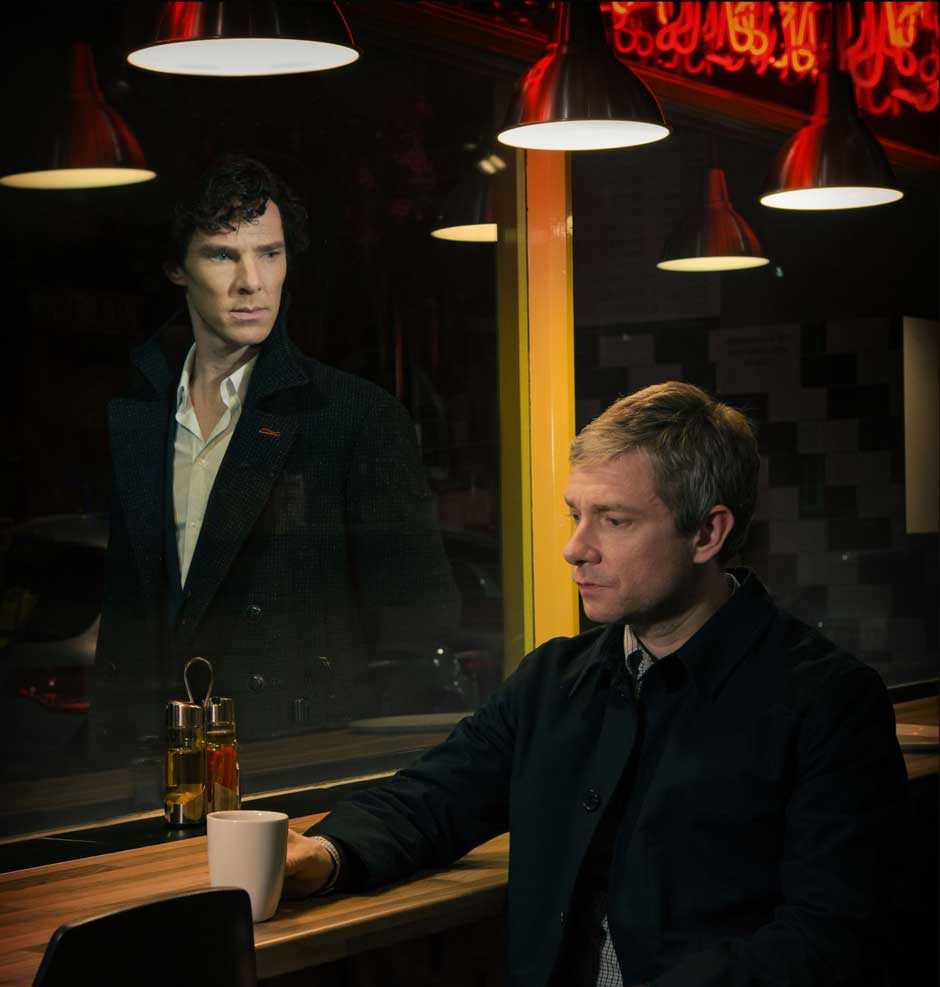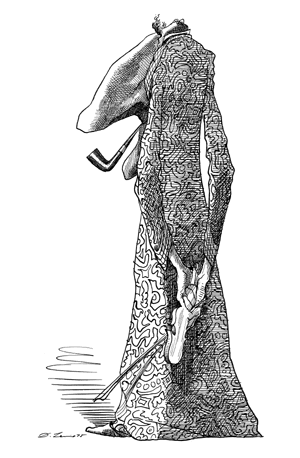At the end of the second season of Sherlock, the great detective (played by Benedict Cumberbatch), in an act of heroic self-sacrifice, apparently plunged to his death from the roof of St. Bart’s Hospital. Or did he?
Set in the present and offering updated and highly imaginative variations on Arthur Conan Doyle’s classic stories, this wildly, and deservedly, popular series began in 2010 with “A Study in Pink,” loosely derived from A Study in Scarlet. In that short novel, published in 1887, army doctor John H. Watson, having been nearly killed during the Battle of Maiwand, has come back to London and is looking for cheap lodgings. When he is introduced to the enigmatic Holmes, the latter takes a quick glance and states, “You have been in Afghanistan, I perceive.” In the twenty-first-century version, broadcast on PBS, the world’s first and only consulting detective says even more bluntly, “Iraq or Afghanistan?”
Suffering from post-traumatic stress disorder, the modern-day Watson (brilliantly portrayed by Martin Freeman) gradually recognizes that he actually misses the adrenalin rush of battle and soon finds its equivalent in assisting Holmes. Over the course of “A Study in Pink” and five subsequent cases, this dynamic duo gradually becomes close friends. So when Holmes, in order to thwart the deadly plans of his nemesis, James Moriarty, leaps from the roof of the hospital where the two men originally met, Watson is devastated. As the third season begins, he has been grieving for two years, but has, with difficulty, finally begun to move on. And then, on the very evening of his marriage proposal to Mary Morstan, in a crowded restaurant, a smarmy French waiter removes his glasses, drops his fake accent, and utterly destroys Watson’s hard-won and fragile equilibrium.
“The Empty Hearse,” the first of three interconnected episodes in this season, focuses our attention on Holmes’s attempts to win back Watson’s trust and affection. There are many delightful touches, including a glimpse of a couple who might be the detective’s parents. I say “might be” because the show leaves almost everything open to doubt. For instance, it presents several different explanations for the “magic trick” at St. Bart’s, and never reveals if any of them are correct. Moreover, the show’s action, rather more choppy than usual, feels distinctly stylized, almost metafictional. It even includes videos, supposedly submitted by young Sherlock fans, that explain how their hero might have survived his fall. At regular intervals, too, the action actually pauses so that the camera can linger on the Byronically handsome Cumberbatch, brooding Batman-like over the city of London.
The in-jokes proliferate. “British Birds”—a scholarly reference book in the original Conan Doyle story “The Empty House”—appears here as a porn magazine of that title. Some mysterious business involving a subway train builds on the plot of Conan Doyle’s not-quite-Sherlockian whodunit “The Lost Special,” in which a privately hired train disappears on its journey from Liverpool to London. The show also borrows from the past for bits of action and dialogue. For example, the revelation scene in the restaurant, which hinges on the similarity between a waiter and a gentleman in evening clothes, recalls G. K. Chesterton’s classic Father Brown mystery, “The Queer Feet.” And when Sherlock’s brother Mycroft exclaims, “The noise! And the people!,” his words echo actor Ernest Thesiger’s famously campy description of the front in World War I.
While Sherlock continues to be exceptionally entertaining, I can’t help but wonder if it has grown a little too self-aware and too reliant on punning riffs for its titles, plots, and in-jokes. Even “The Giant Rat of Sumatra”—the most tantalizing of those untold cases for which the world is not yet prepared—is repurposed in this episode. Every element in “The Empty Hearse” feels a bit overstylized, artificial, almost going beyond the tongue-in-cheek. Certain riddles are also deliberately left unresolved, since they need to prepare the viewer for the two subsequent episodes. Still, the creators—Mark Gatiss and Steven Moffat—recognize that the chemistry between Holmes and Watson is what ultimately matters most and that seems to have been re-established. I look forward to “The Sign of Three” and “His Last Vow.”
A final note: Because Sherlock tends to rework cases from the original adventures of the sleuth of 221B Baker Street, it feels more authentic than CBS’s concurrent, but equally superb Elementary, starring Jonny Lee Miller and Lucy Liu (as Dr. Joan Watson). It is set in New York in the present, and uses many names and details from the stories, in particular, Holmes’s drug addiction, but the plots are wholly original. Last year, the first season concluded with a terrific shock, as the detective, still recovering from emotional trauma, finally confronts his archenemy Moriarty.
Advertisement
More personally, I would point out that in the opening episode of this fall season’s Elementary, Holmes is briefly assisted by a character named Langdale Pike. In 2002 I was invested into The Baker Street Irregulars, the 80-year-old society devoted to the study and appreciation of Sherlock Holmes. As part of the investiture ceremony, inductees are given a new name, chosen from the “canon,” to match, more or less, their character or profession. Mine is…Langdale Pike. He’s a gossip columnist in the very worst Sherlock Holmes story, “The Three Gables.” Still, early on in their investigation, the great detective turns to the good doctor and declares, “Watson, this is a case for Langdale Pike, and I am going to see him now.” I like to think I was able to draw Holmes’s attention to a few curious points.
The third season of Sherlock can be seen on PBS. For more information, visit pbs.org/wgbh/masterpiece.




